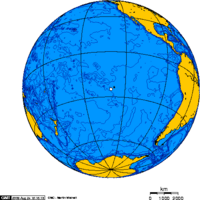Pitcairn Island
 From Citizendium - Reading time: 3 min
From Citizendium - Reading time: 3 min

View centered directly over Pitcairn Island.
Pitcairn Island is a small, extremely remote island in the eastern Pacific Ocean, primarily known as the home of the mutineers made famous by the events depicted in the book and film versions of Mutiny on the Bounty. It is 3590 miles west of Santiago, Chile, and 1312 miles east of Papeete on the island of Tahiti. [1]
The island is hilly, and has no natural landing places, and no good anchorages. Nevertheless there is evidence that there was some settlement at the height of the Polynesian colonizations of the Pacific.
The island is of volcanic origin, and is part of a chain of seamounts.[2]
The island's first recorded sighting by European explorers was by Midshipman Robert Pitcairn on July 3, 1767.[3] Pitcairn was sailing on board HMS Swallow, Captained by Philip de Cateret.
Following the events dramatized in the various versions of the Mutiny on the Bounty, a faction of the mutineers, led by ringleader Fletcher Christian, anticipated that the Royal Navy would send out an expedition to capture the mutineers. They decided to take the HMAV Bounty and find a less-settled island, where the Royal Navy would be unable to find them.
Christian's small faction was joined by a small group of adventurous Tahitians. They eventually picked Pitcairn, several thousand miles from Tahiti. After landing supplies from the Bounty the mutineers wrecked the vessel—meaning there was no escape.
All but one of the men in the expedition died within twelve years of the settlement. Most of the men murdered one another. The Tahitian women, and the one surviving mutineer, and several dozen children, lived in isolation on the Island until a visit by an American whaler in 1808.
At its peak the number of descendants of the mutineer's expedition numbered over two hundred -- straining the resources of the Island. In 1856 British authorities re-settled many of the descendants on Norfolk Island. Norfolk is a larger Island closer to Australia. When Australia had been a penal colony, Norfolk Island had been where Australian authorities sent the most troublesome convicts. But the convicts had been removed when the Pitcairn descendants were sent there.
Several hundred descendants of the Pitcairn expedition live on Norfolk, while several dozen descendants remain on Pitcairn.
In 2003 a visiting police official from Britain, who had been assigned to train a local constable, leveled allegation that the males on Pitcairn had engaged in sexual relations with girls below the age of consent, in many cases against their will, a practice which prosecutors said had been widespread and had gone on for many years. Six men were convicted; three of them were sentenced to jail for terms ranging from three to six years. After their appeals were denied in 2006, the convicts had to build their own prefabricated prison, shipped in pieces from the U.K., where they will be guarded by a rotating staff of guards from New Zealand at a cost of almost USD 1,000,000 a year.[4][5]
References[edit]
- ↑ http://library.puc.edu/pitcairn/pitcairn/map.shtml
- ↑ Adams Seamount, Global Volcanism Program. Retrieved on 2008-08-20. mirror
- ↑ Pitcairn Island Study Center. Pacific Union College. Retrieved on 2008-08-24.
- ↑ Britain to Set Up Jail for 6 on Pacific Island, New York Times, October 31, 2006. Retrieved on 2008-08-24.
- ↑ Rapist relative of Bounty's mutineer enters his DIY jail, The Observer, November 19, 2006,. Retrieved on 2008-08-24.
 KSF
KSF